How to Make an Award Winning Garden Design
It’s that time of year when you look at your garden and wonder… How can I make it better?! My garden has been a long process but I have a few tips & tricks that may help you make your’s also be noticed. Let me share how to make an award winning garden design since it worked for me.
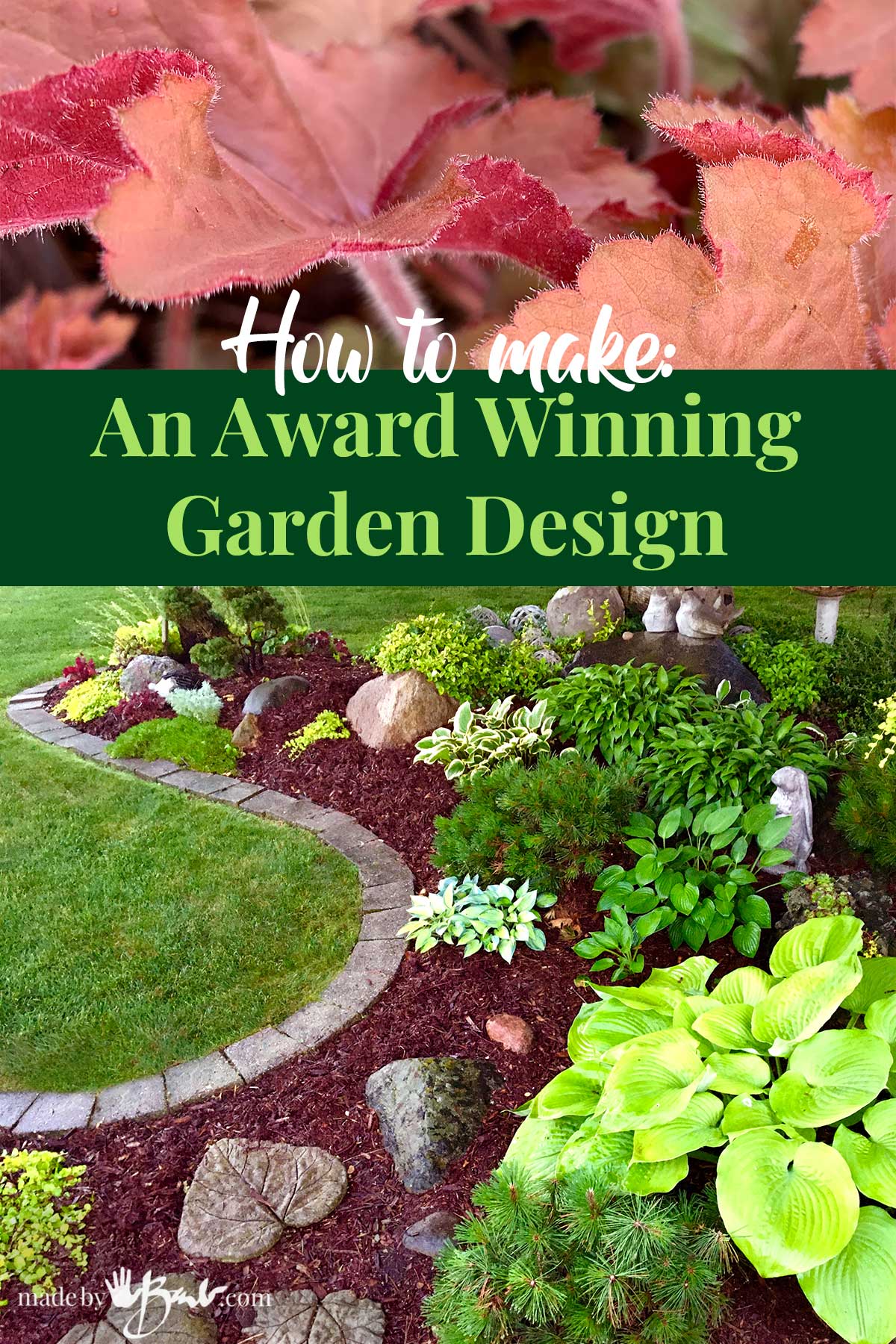
First, let me say, this is not boasting about my garden. I am not a landscape architect but as you know, I’m an artist & designer, and therefore, I look at everything as a piece of art. The elements of design are; line, shape, space, colour, texture and pattern. I remember learning that from design class in art college and it influences all my design ideas in every media. Those same principles can also be applied to garden design. Since gardens are usually not just ‘born’ I have learned much over the life of my garden.
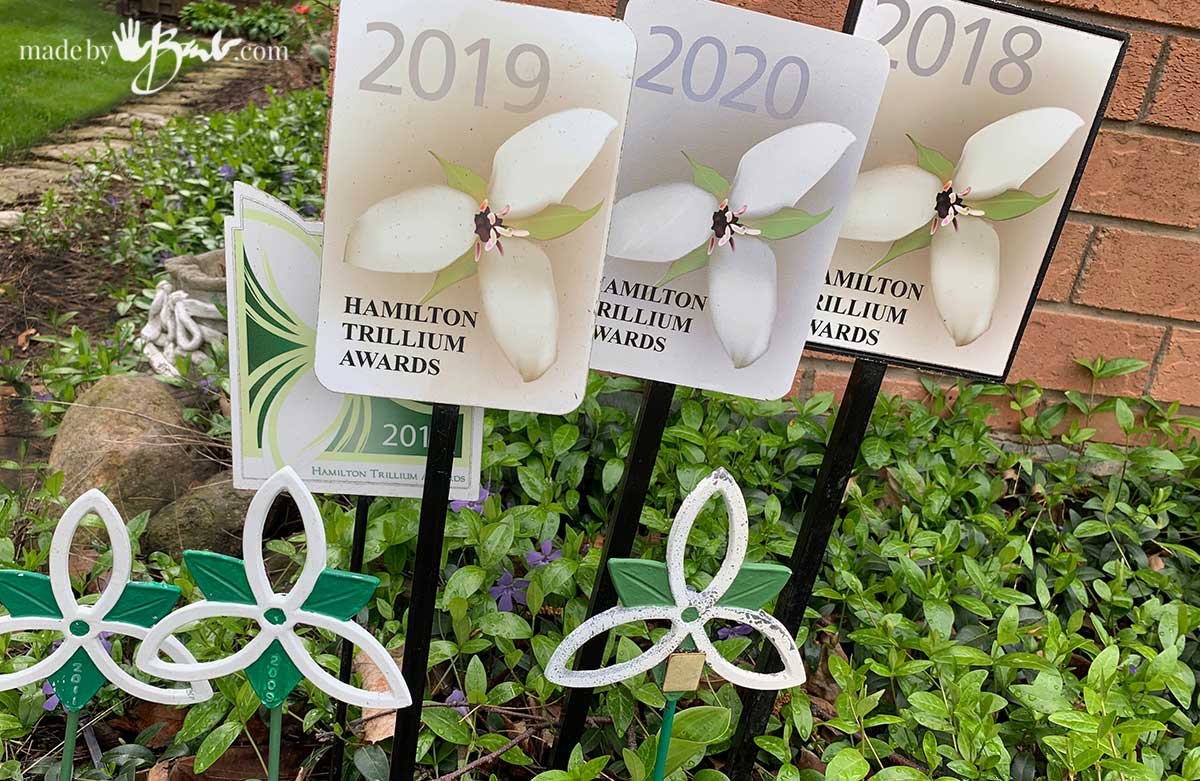
Garden Awards:
Where I live, there is a volunteer committee that will judge gardens across the city for awards. Sometimes it involved nominations, or just checking out all the gardens. After I had surprisingly won a few times I was also asked if I wanted to judge. It was quite a fun activity. The judges were also given some guidelines but I also realized what made certain gardens stand out. Again, I saw similar grading criteria. Honestly, it isn’t all about how ‘green’ your thumb is!

What plants are best?
Before looking at design principles I’ll share what plants I love best. Since my garden is now 33 years old I have changed my thinking about my choice of plants. When just starting I chose bushes and evergreens; not realizing that they would eventually get quite large. I saw that pattern often in the neighbourhood. I want to enjoy the garden, not be trying to dig out huge bushes that became unmanageable.

For that reason I have come to realize that the Hosta plants are my favourite. I am in a zone 6 area in southern Ontario. See how the Hostas (Plaintain Lily) sprout up in the spring. This perennial plant returns every year with new leaves and such sweet bouquet formations. The leaves of the Hosta come in a variety of colours, sizes and shapes. Later in the season the plant also sends up shoots of flowers.

Another reason that they are my favourite is that they can easily be divided and therefore create (propagate) more plants. Neighbours will often share as well. The root system does not go very deep, just a sharp shovel will cut a mound easily to pop out and move. It is best to do that just as you see the tips come up in the spring. That is much easier than digging out a 15 year old juniper…

To save money from buying annual flowering plants every year I like to use the colours of the perennials. Blues, greens, and yellows including variegated varieties of Hosta are available to add that visual interest.
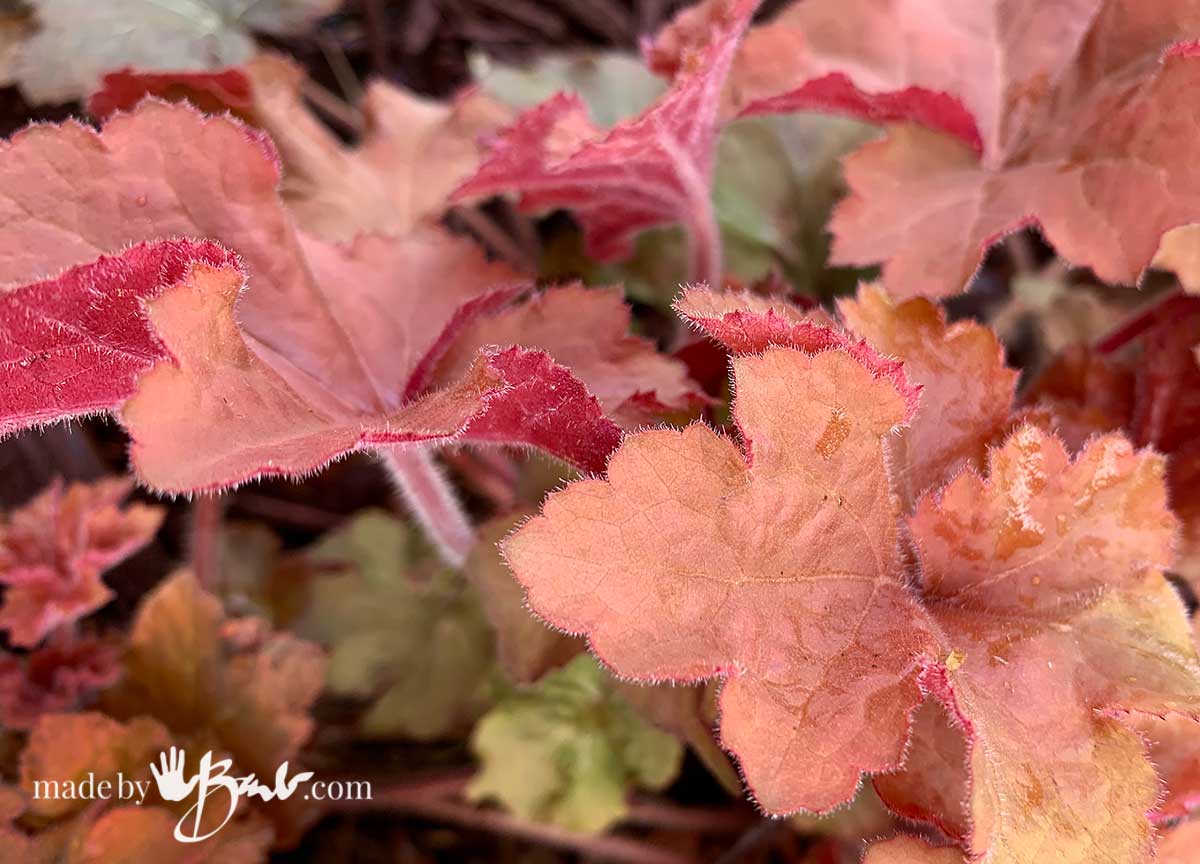
Colourful Ideas for the Garden:
Another favourite perennial is the Heuchera as it also comes in a variety of colours. There are red and pink varieties that will also have small blooms later in the season. I am less concerned about a flower garden but more a garden bed of colours and shapes. Blooming plants often do not last as long and may require more watering and maintenance than I’d like. A clump of White Birches helps shade the garden but also gives much raking of leaves in the fall. Hostas will lose leaves in the fall so it allows easy cleanup.
A few bulbs of your choice can be an colourful addition for late spring until the perennials have regrown.
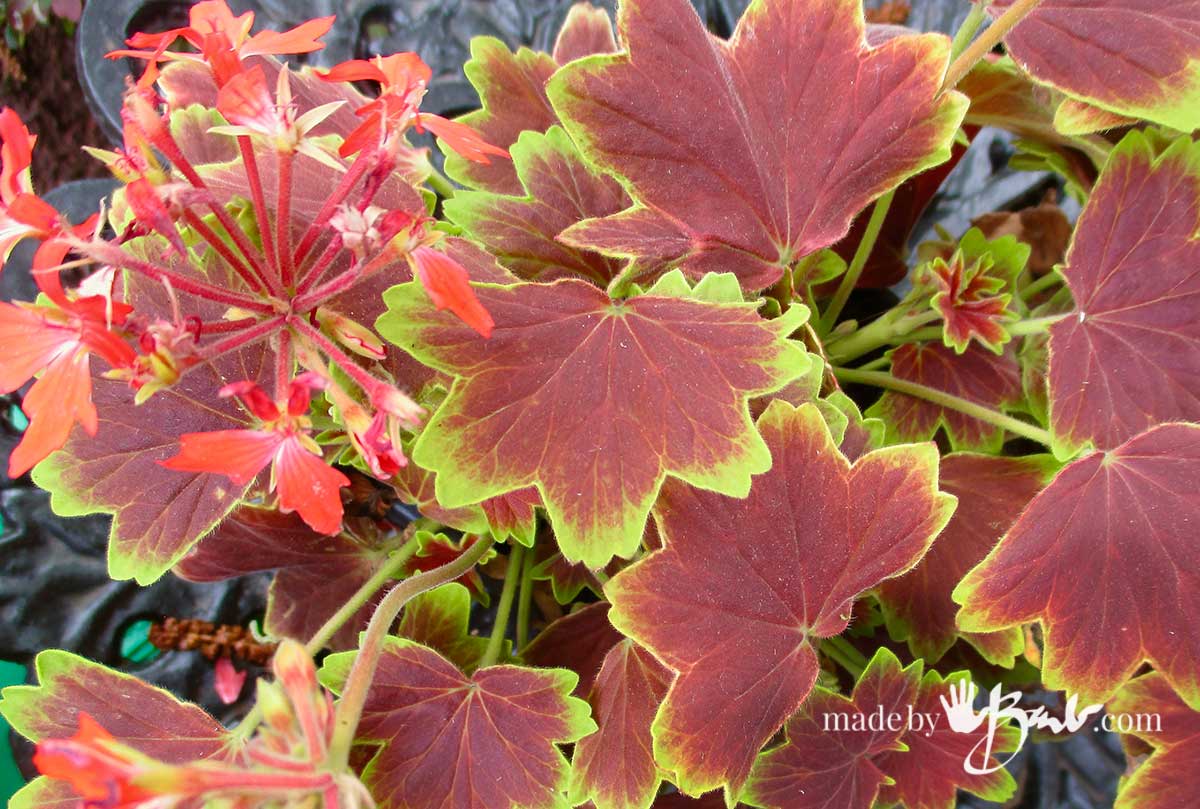
Foliage (leaves) can come in a huge variety of colours that can be as bright as blooms. This Geranium as well as other annuals like the Coleus can provide amazing colour throughout the season, without having to depend on the amount of care needed for blooms. I am never disappointed with them.
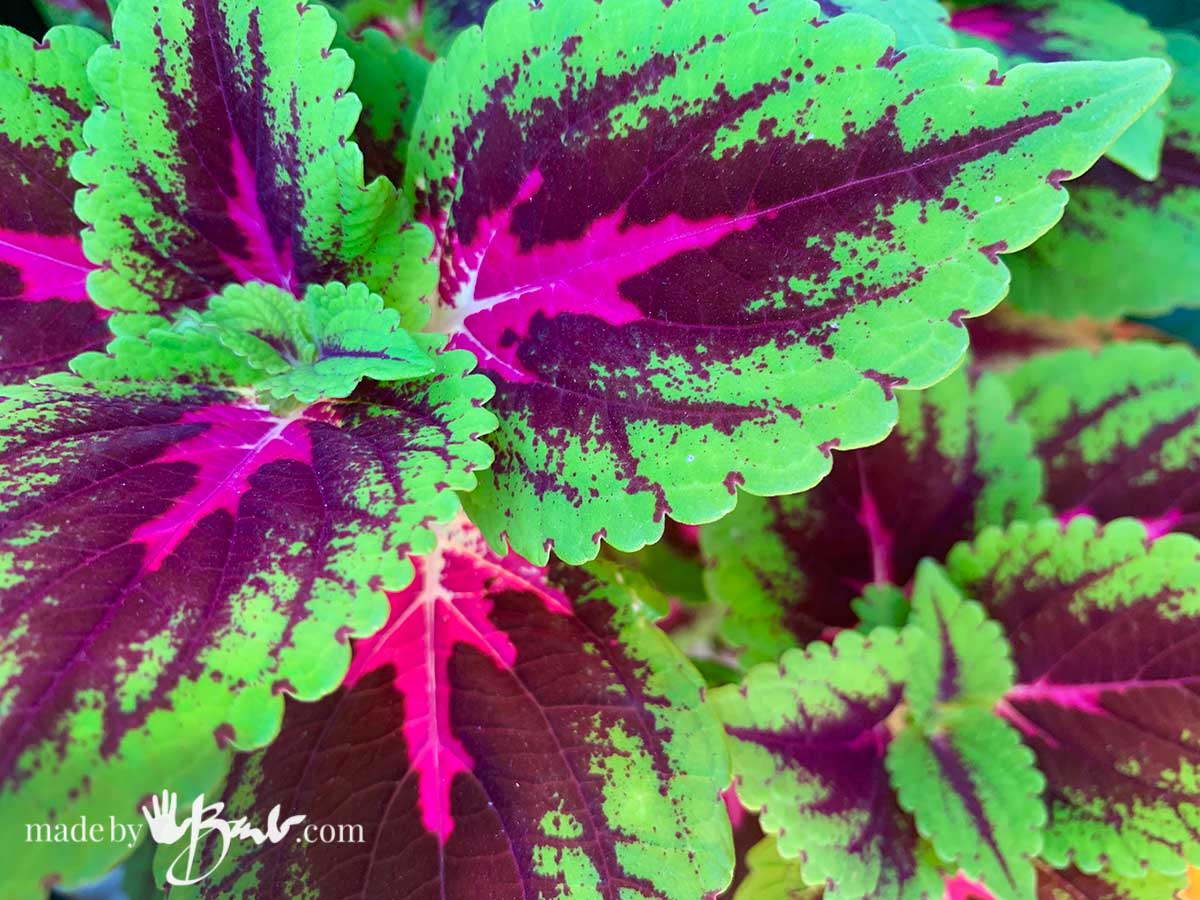
Since these are annuals they will also not become unmanageable.

Funny story; I do not remember planting these Grape Hyacinth (Muscari) and they seem to sprout up first in spring to give some refreshing colour after the long winter here in Canada. To inhibit weeds I use a dark mulch. If you keep an eye out for the odd weed, you will not lose the battle.

Consider Shape and Space in Garden Design:
Since I am a visual person I expect a certain amount of organization in the design; that makes it easier on the eye to view. A landscape designer considers size and shape of each specimen. Give each plant it’s own space and limits. Maintaining the shape will also keep them from becoming entangled. I understand everyone has their own idea and style. I like some order rather than chaos in my environment. The Red Barberry (Berberis thunbergii) combines a lovely red with green foliage but will need a trim to keep it dense.
Just like you were jewelry to accent your wardobe a few ornamental shapes of Garden Orbs compliment in a similar subtle way. I choose shapes colours that look natural in nature.
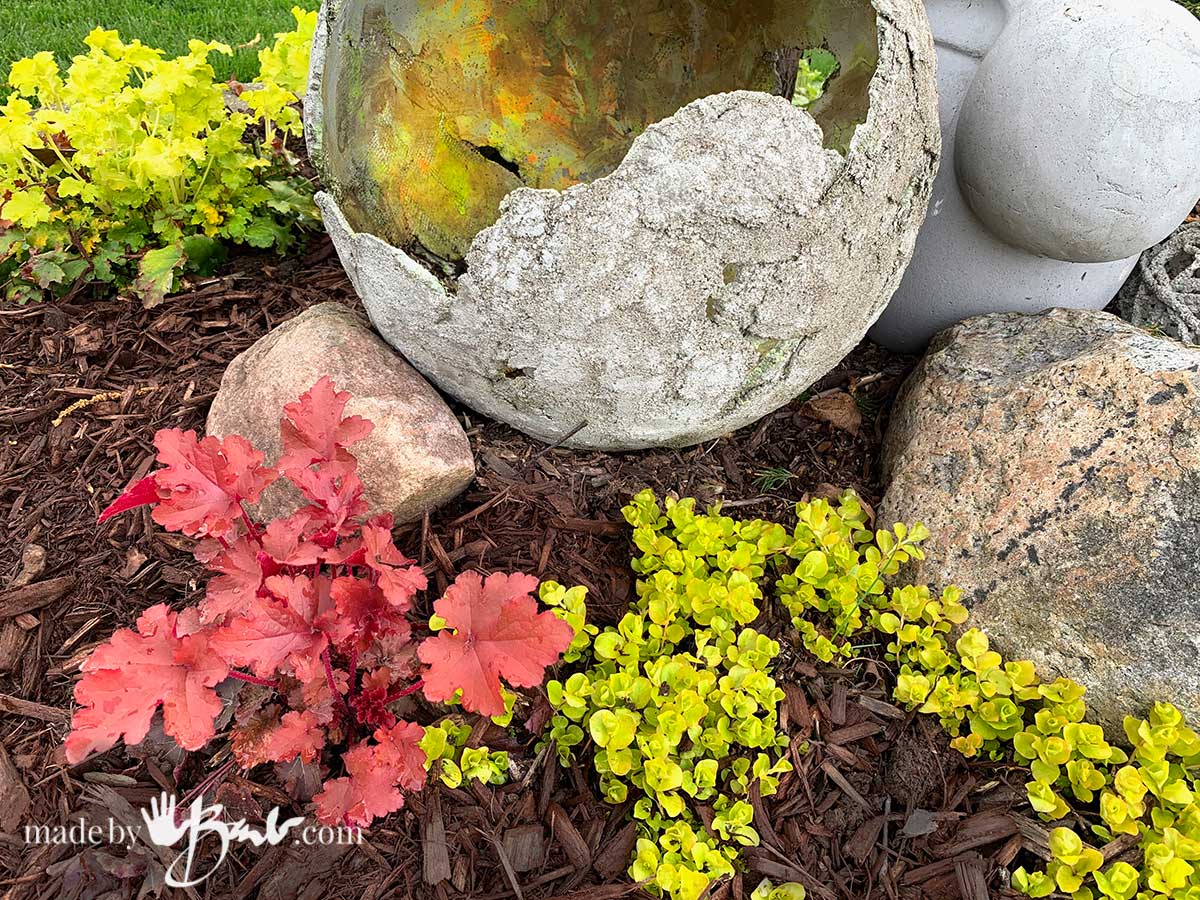
Texture in multiple ways:
Yes, texture is everywhere in an outdoor space; shrubs, rocks & stones, ornamental grasses, and even hard landscaping like fences can add interest. As you may recognize the nature inspired textures of the Giant Orbs or Giant Leaf Orb have an aged stone finish.
My choice of landscape topping is a cedar mulch in a dark brown to keep the soil from drying too quickly and also to mimic the colour of rich soil. It is topped up a bit each year.

Can you believe that I picked up this sculpture from the side of the road as a cast-off?! I think it is made with marble dust as it seems to somewhat melt away more each year. The chartreuse colour ground cover Creeping jenny is actually an annual for planters but seems to sprout up new each year – bonus! Please do not let any ground covers grow into natural spaces since they are not native to the areas.
The reddish Voodoo Creeping Red seedum (Sedum spurium) is so versatile as it can just be cut and put into planters and concrete bowls. I think I only ever bought one plant!

Pattern as predictable or random:
Pattern in design can be interpreted in a few ways. When I add some elements like ornamental additions I like to keep them grouped (in odd numbers) rather than sparsely scattered. The repetition or groupings make more of a statement that way.
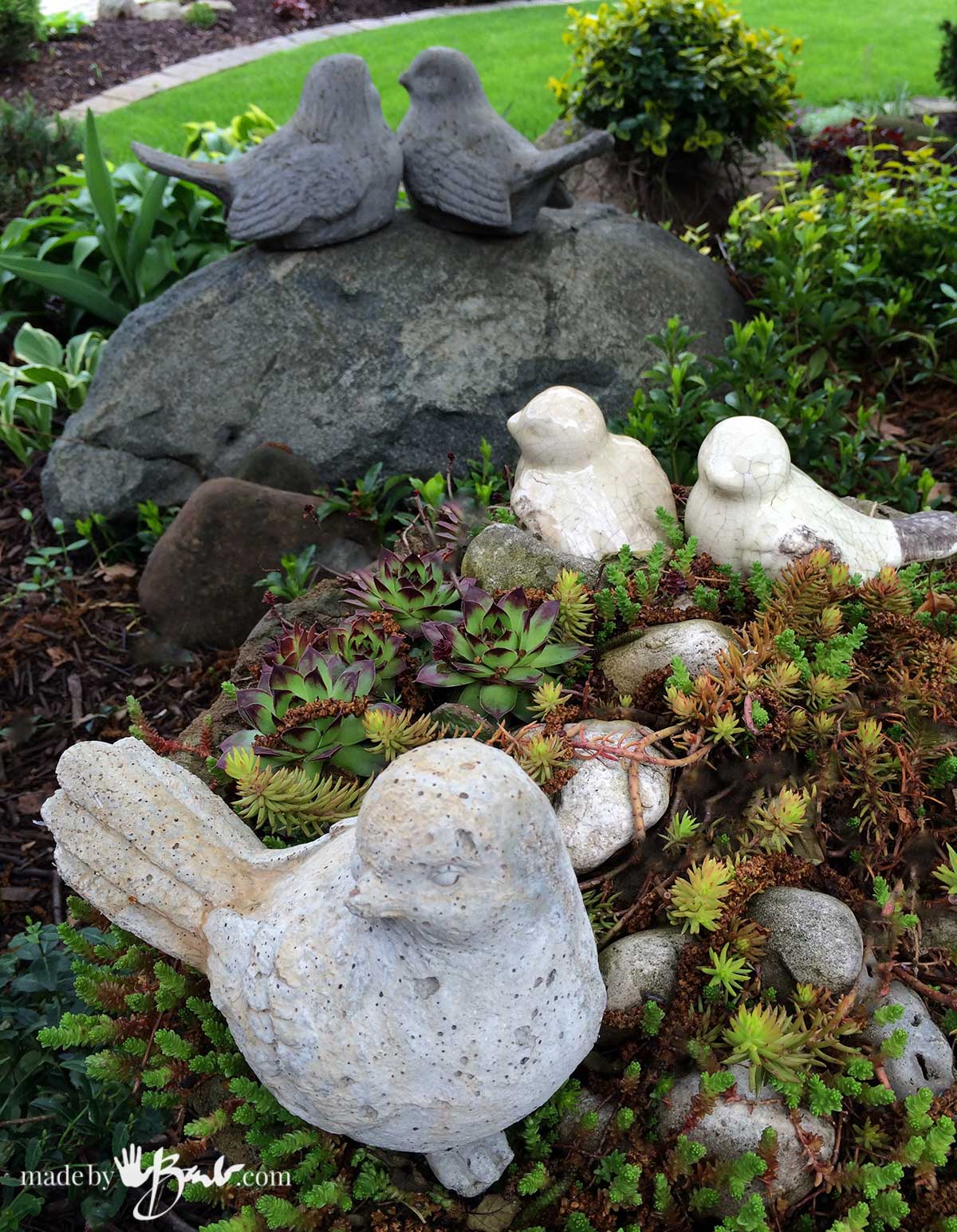
Unexpected themes can add a bit of garden whimsy. I keep my concrete out all year and my castings have held up very well.

Designing a Garden with ‘Line’:
I’ll admit that I like definition, whether in art (good definition of form) or in boundaries of the garden. It adds needed direction for the eye to follow. It this case it is the edging used for keeping the grass contained. I laid the landscaping blocks and adjust them individually when needed. The choices of edging are quite limited, but the adaptability is what I like; since I change my mind a lot, versatility is key!
Please don’t always use a straight line for a new garden… take inspiration from nature. My One Woman Garden Makeover post has been really popular to see how to plan a garden shape.
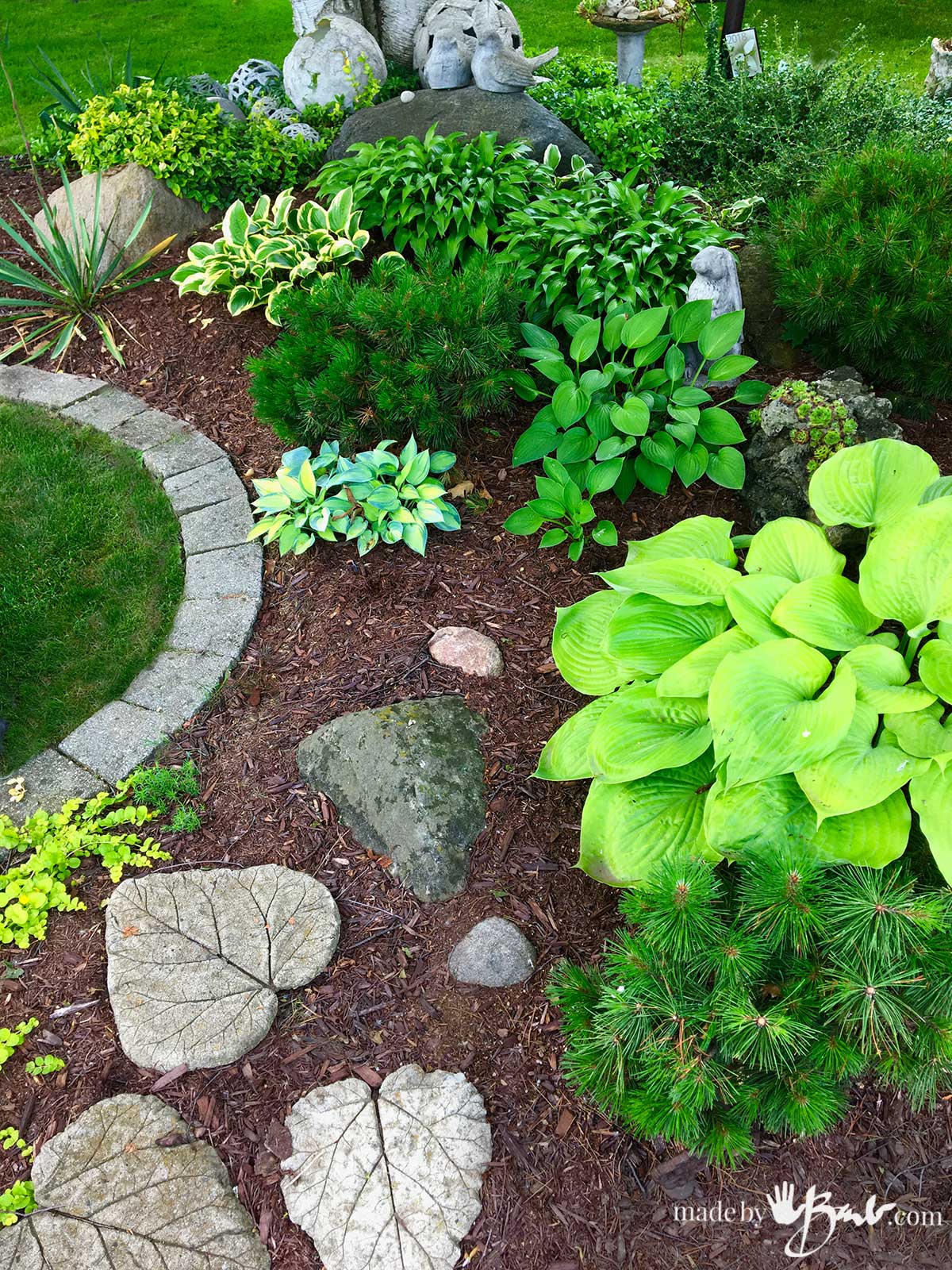
I have often found that plants outgrow the small gardens we start with. Give the plants some room to grow and a few space to step through. These leaves make great use of the leftover Rhubarb leaves.

Long sweeping curves take your eye through the garden. It’s one of the best ways to give the illusion of design purpose. Keep the edges at the sidewalk precise as well, maybe it’s the genes of having a barber in the family…

I hope I have inspired you to get out and garden… It is a very therapeutic past-time. Don’t be too critical and realize it is an ever changing design. Don’t be fooled this has changed so much over the 33 years.

Unexpected Elements:
What do you see?! It was quite by accident that this juniper resembled a bird, but now I prune & maintain that shape as a focal point. That topiary pruning did get the attention of the judges! The succulent garden at the curb gets more sun than under the trees so it adds another zone. Snow gets piled there in winter so low plants are prefect.
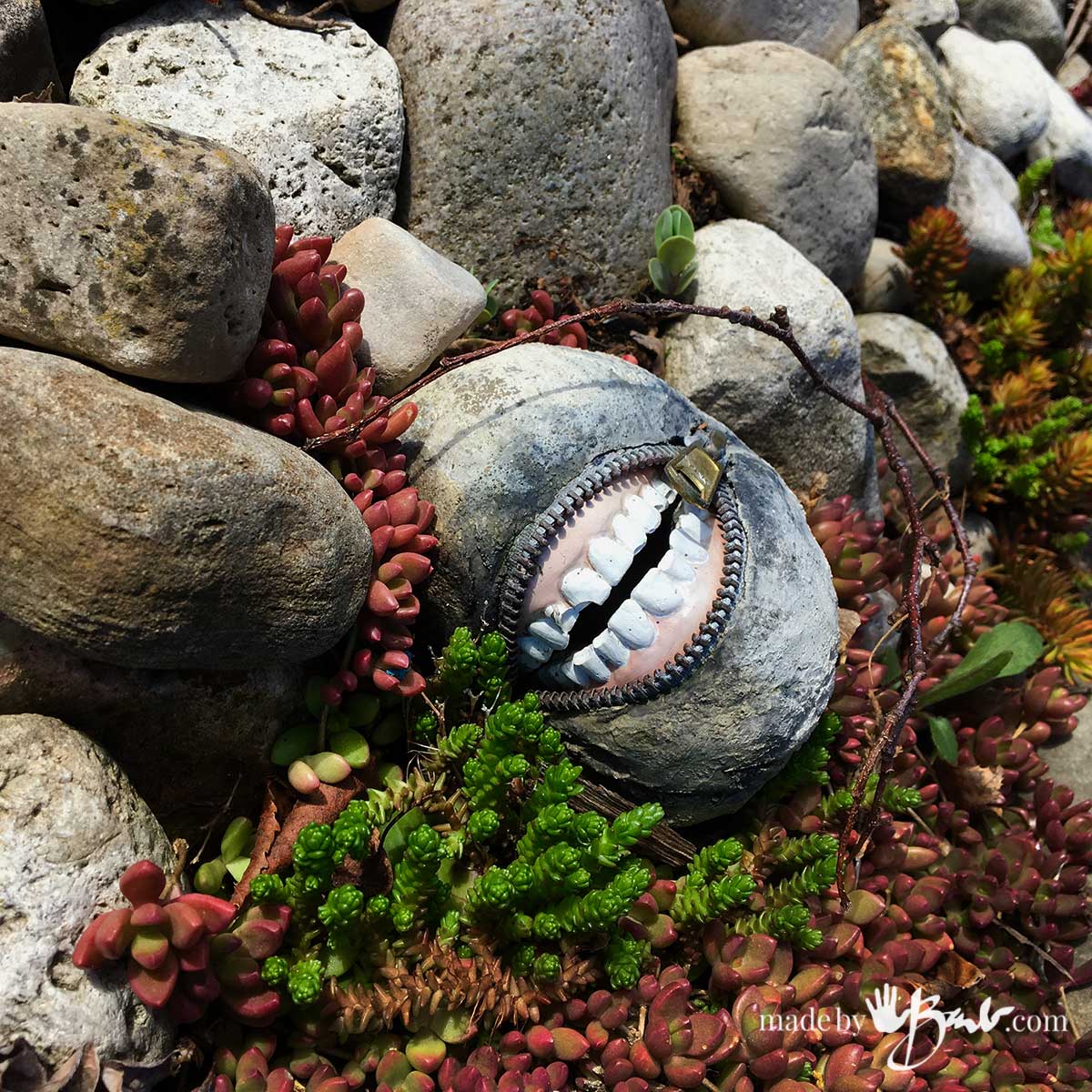
Unexpected garden elements in my front yard make passersby smile… Would you like a garden like this? It is now so much more manageable after years of figuring out what plants are the best for me.
Here’s to helping you make more happy green surroundings… Whether it’s a backyard or front.
Hi Barb, I live in NB, Canada. Just wanted to say that I’ve gotten so many ideas from your posts. Especially with concrete. Is there nothing you can’t do!! 😊
Hello fellow canadian! There’s some things I do not have control over… Spread the word, so that I can continue to provide.
Nice article on designing your yard. Shows off all your concrete projects. Love the mouth with the zipper!
Thank you! I aim to have them blend in…
Lovely, lovely garden, art, yard!!! By the way, what is the red succulent in the last photo? thanks.
Oh that is usually more green but in the fall it’s more reddish. I think it is Sedum album ‘Murale’. I have a section with a few succulents that need to to be trimmed so they don’t intermingle too much.
I love your gardens! Very inspiring I also like my gardens to be organized vs messy and wild. I appreciate your comments about leaving space for your plant to grow and avoid plants that just overgrow and end up being a pain to remove. And your mix of non-plant internet is phenomenal and so inspiring! Thank you for sharing!
I am a visual person so I need ‘organization’ to not be overwhelmed. Happy gardening!
Hi Barb!! Just found your site “The One Woman Garden Makeover.” LOVE IT! May I ask you for advice on making a garden in our back yard. Newer house, concrete patio, 2 dogs that have to escape from that patio, full sun, bermuda grass that grows slightly over patio, and some concrete blockage under the earth next to concrete patio (probably from when they laid out the patio)… other that there is no problem. 😊 Good news is that it is a large back yard, just don’t need too large a garden. Would appreciate any advice (love perenals). Thanks, Dottie 😊
It will depend on the zone you are in. Before I make decisions that will be very permanent I like the versatility of smaller specimens that can be trimmed or taken out if needed. A tree is a decision made wisely. Recently I had to do some reshaping due to the Box-moth attacking my topiary boxwood bushes but since they are not that big I managed to still keep some portion. I am quite the ‘pruning queen’! I would look into some scrubs that could allow some shaping to provide some relief for the pups and also not too much fast growth. What Zone are you?
Made by Barb’s guide on how to make an award-winning garden design offers insightful tips, creative ideas, and step-by-step instructions to help you create a stunning and cohesive garden that stands out.
Thanks!
love your designs!
Thanks so much! Trust your instinct to when you like something and go from there… Good luck!